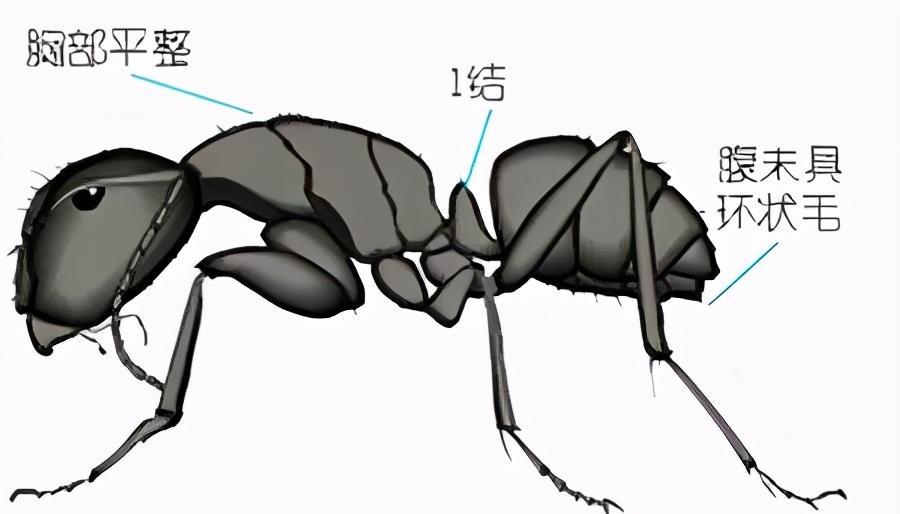Black Carpenter Ant Black Bowback Ant
Camponotus pennsylvanicus
Differentiation: The chest is flat, there is only 1 knot between the chest and the abdomen, and there is a ring of hairs at the end of the abdomen.
Size: Big Worker Ant Approx. 7/16" Mini Worker Ant Approx. 1/4"

Black bow-backed ant
"Red" Carpwnter Ant Red Bowback Ant
Camponotus sayi
Size: Big Worker Ant Approx. 1/4" Small Worker Ant Approx. 3/16"
Red bow-backed ant
Field Ant
Formica spp.
Identification: the chest is uneven, there is only 1 knot between the chest and the abdomen, there is a ring of hair at the end of the abdomen, and the head has a "fontanelle".
Size: Approx. 3/8"
Field ants
Small Honey Ant Small Bee Ant
Prenolepis impairs
Identification: the first section of the antennae is longer than the head, the lateral view of the chest is uneven, the chest is thinner when looking down, the abdomen is like a triangle, wider than the head, and there is a ring of hairs at the end of the abdomen.
Size: Approx. 1/8"
Little bee ants
Large Yellow Ant Rhubarb Leafcutter Ant
Acanthomyops interjectus
Identification: small eyes, uneven chest, only 1 knot between the chest and abdomen, a ring of hair at the end of the abdomen, crushed after death will emit a "lemongrass" smell.
Size: Approx. 1/4"
Rhubarb leafcutter ant
Odorous House Ant Sour Ant
Tapinoma sessile
Identification: The chest is uneven, there is only 1 knot between the chest and the abdomen, there is no ring-like hair at the end of the abdomen, and the pinch will emit a "coconut" smell.
Sour ant
Thief Ant theft ant (fire ant genus)
Solenopsis annoying
Identification: there are 10 segments of the antennae, no spikes in the dorsal plate of the posterior thorax, 2 knots between the chest and the abdomen, a spine at the ventral end, and 2 segments at the end of the antennae.
Size: 1/32" to 1/20"
Theft ants (Fire Ant)
Pharaoh Ant (Little Yellow Family Ant)
Monomorium pharaonis
Identification: there are 10 antennae, no spikes in the posterior thorax dorsal plate, 2 knots between the chest and abdomen, no spines at the ventral end, and 3 segments at the end of the antennae.
Size: Approx. 1/16"
Pharaoh Ant (Little Yellow Ant)
Little Black Ant
Monomorium minimum
Identification: there are 12 segments of the antennae, no spikes in the posterior thoracic dorsal plate, 2 knots between the chest and the abdomen, no spines at the ventral end, and 3 segments at the end of the antennae.
Little black house ant
Acrobat Ant Lifting Ant
Cremastogaster lineolata
Differentiation: there are spikes in the dorsal plate of the posterior chest, 2 knots between the chest and the abdomen, no thorns at the ventral end, and the abdomen can be lifted when disturbed to show a warning, and the abdomen is heart-shaped from top to bottom.
Size: More than 1/8"
Raise the belly ant
Pavement Ant, Pavement Ant
Tetramorium caespitum
Identification: 3 segments at the end of the antennae, a prick in the posterior thoracic dorsal plate, 2 knots between the thorax and the abdomen, a spine at the ventral end, and a groove covering the head and thorax.
Road ant, pavement ant
Big-Headed Ant
Pheidole spp.
Identification: the first segment of the antennae is short, the posterior thorax dorsal plate has a spike, and there are 2 knots between the chest and the abdomen; the worker ant has 2 sizes, the big worker ant has a very large head, and the head of the small worker ant is proportional to the body and more coordinated.
Size: Big worker ant about 1/8" small worker ant about 1/16"
Big-headed ants